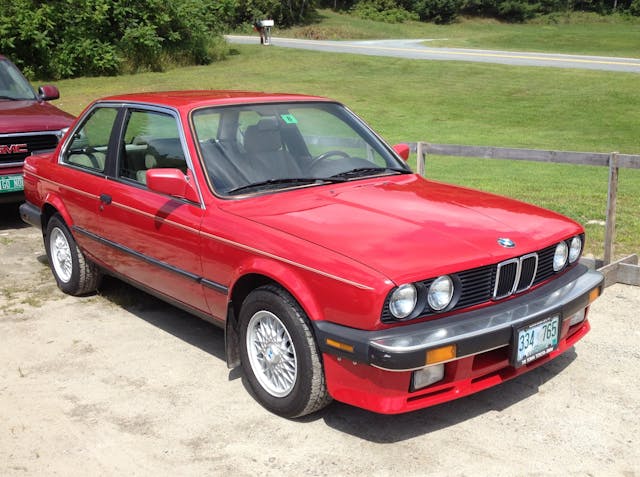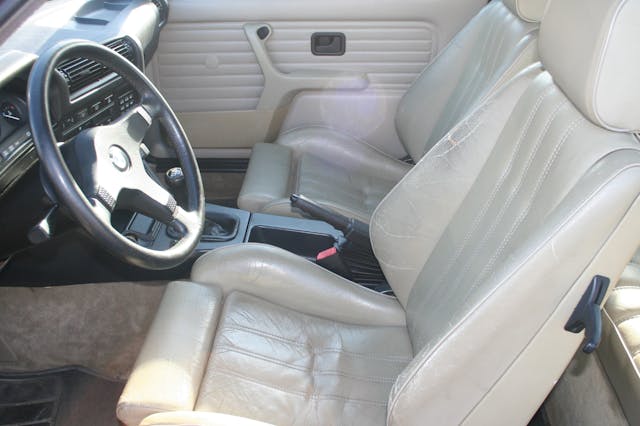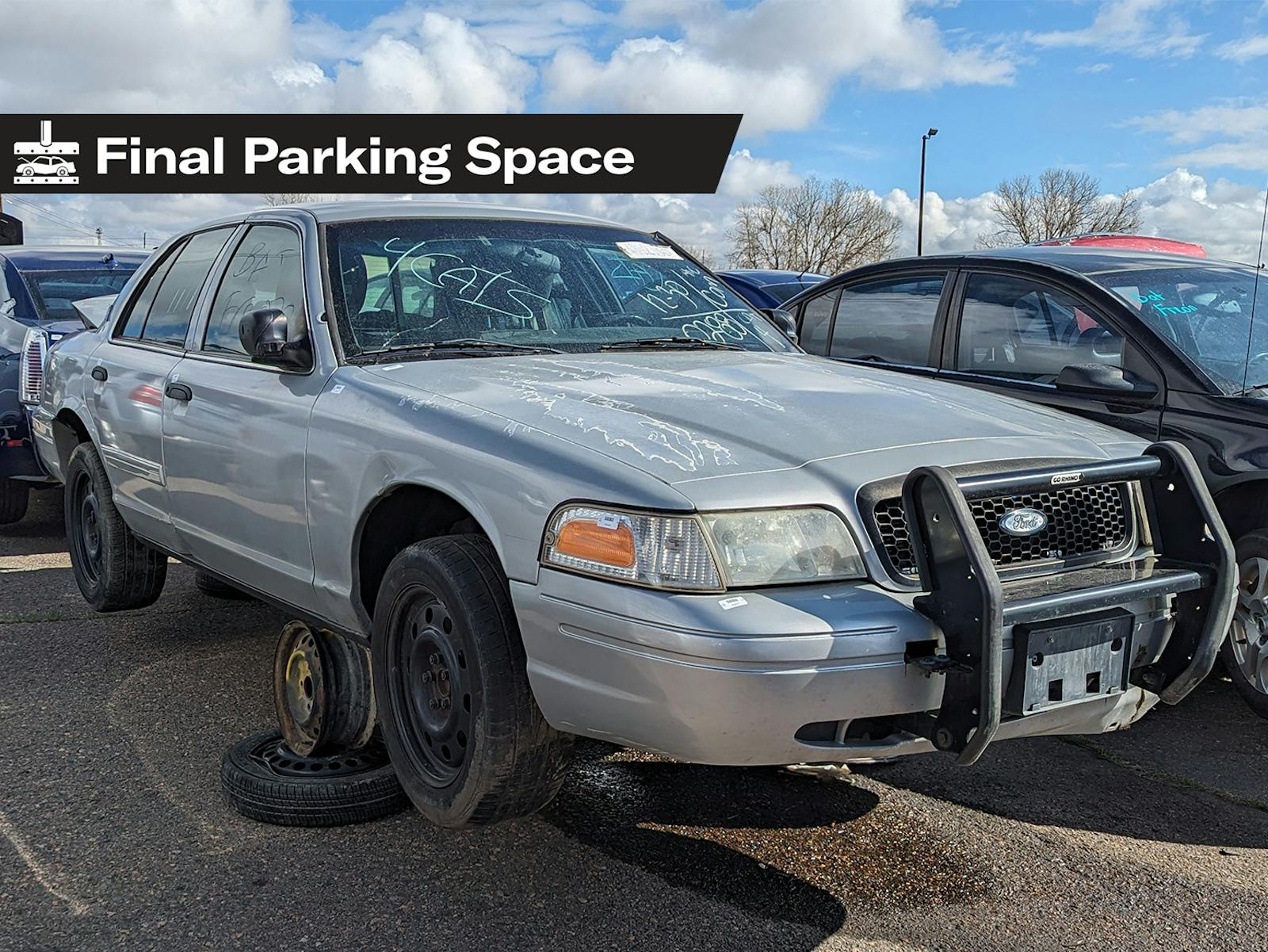The Trade: Selling one car to buy another, with no regrets (OK, some)

Last week, I wrote about the two biggest enabling factors in buying and owning more cars than I should—inexpensive insurance and ample storage space. I left out the most obvious one—money. But there’s a reason.
For the most part, being the bottom-feeder that I am, I’m generally looking in the $4000 range for the “whim-able” cars (“I always wanted one of these—oh look what the gods just dropped onto Craigslist an hour’s drive from me”) that comprise about half of my not-a-collection. I usually can scrape together four grand, and thus, whether or not I pull the trigger on something usually has more to do with available space than with the money. However, there was one memorable instance where I made an explicit decision to sell A to enable me to buy and hold onto B.
Most vintage car buying is pretty simple—we’re attracted to the cars we lusted after in high school or college, couldn’t have then, but can have now. This, along with some specific “imprinting” examples from my adolescence, explains my attachment to the purity and simplicity of 1970s-era BMWs like the 2002, Bavaria, and 3.0CSi, as well as my Lotus Europa Twin Cam Special. We may admire other earlier or later cars, but that admiration often lacks the same bone-level craving we have for those cars we wanted when our hormones and sebaceous glands were in high gear.
So, on one hand, it’s surprising that in 2014 I bought a 1987 BMW E30 325is. I freely admit that I never bought into the mystique of both the E30 3 Series and the E28 5 Series cars. I like them—I had multiple examples back in the day as 10-year-old daily drivers—but the mantra about them being the last BMWs designed for 300,000-mile service lifetimes and the over-the-top hype about the E30 being “God’s chariot” never resonated with me. I don’t care that Molly Ringwald got into Blaine’s E30 in Pretty in Pink. If anything, that car was literally the poster child for BMW during those awful yuppie years when people with daddy’s money referred to them “the Beamer,” something folks like me wanted absolutely nothing to do with.
Nonetheless, I’m a practical guy, and in 2014, with so many E30s having been cut up, boy-racered, and stanced, original E30s had already started climbing noticeably in value. I’m a firm believer in going to see promising cars with my own eyes if they’re within striking distance, so when I found the highly-original Zinnoberrot ’87 325is with 140K miles advertised for sale on Craigslist in Rutland, Vermont, for $4000, and then spoke with the seller and learned that he was a mechanic, it was his wife’s car, they’d owned it for 17 years, kept it garaged, and it was nearly rust-free, I was interested enough that I got the car’s VIN, verified that it had a clean CarFax, rented a U-Haul auto transporter, hitched it to the Suburban I still owned, and drove the three hours up to Rutland.
Now, the E30 325is is a funny car. It’s technically not a separate model according to the database that sites like realoem.com draw from; it’s more a set of options that, in the United States, were together badged as a 325is. These options include sport seats, limited slip differential, M sports suspension, sports steering wheel, rear spoiler, a different front air dam, an oil cooler, and ducted brake cooling. Some of these show up when you run the car’s VIN through a site like mdecoder.com, but some don’t.
Upon arriving in Rutland, I first got an overall sense of the car. It did appear to be what the seller said—an unmolested big-bumpered 325is (1987 was the last year before BMW switched to smaller, better-integrated “world bumpers”). The fact that it showed an almost laughable amount of wheel well above the tires on its original basketweave wheels made it likely that it was still riding on its original suspension. The Zinnoberrot paint was intact, with just some fading on the color-keyed mirror housings. The interior was in good condition, with no dash cracks, and the Pearl Beige sport seats showed wear but no actual exposed bolster foam.

Next, I verified that the car was indeed as solid as the seller said. Since I met him at his shop, he was kind enough to put the car up on a lift. Indeed, it had only a small rust perforation near the sunroof drains at the bottom of one of the front fenders, and a split in the gravel guard on one of the rockers in which rust was beginning to form. It had almost all of its “is” bits intact, only missing one of the brake ducts. I drove it, found very little obviously wrong with it, bought it on the spot for his asking price, and towed it home with the ’Burb.
I had a funny interaction with the seller after I’d loaded the car on the trailer and he and I were shooting the breeze before I hit the road for the three-hour trek home. He was mainly into vintage American iron and was working on the way-cool jet-age interior of a ’63 Thunderbird. I said, “I forgot to ask the usual question: Why are you selling the E30?” He said “Well, you know … mainly the usual issues of space.”
“Plus,” he said, and leaned in toward me slightly, as if he was giving me a big tip he didn’t want others to hear, “I just don’t see it appreciating.” Since the opposite view was precisely why I was there, it seemed like the perfect yin/yang of automotive prognostication.

The car didn’t really need much. The six-cylinder E30’s M20 engine is the only engine BMW built that uses a timing belt instead of a timing chain. It’s an interference engine, so if the belt snaps, it takes the valves and possibly the pistons with it, so unless you have a dated receipt for the repair, prophylactic replacement is in order. The water pump is “in the neighborhood,” so it’s typically done at the same time as the belt. I did both even though they both appeared fine. After I began driving the car, I found that the clutch pedal would slowly sink. I replaced the clutch slave, and the problem did not return. The power window switches required some creative connector resoldering. I found the uber-rare “is”-specific brake duct and replaced a torn boot on the steering rack. To pretty the car up, I replaced the faded BMW emblems on the hood, trunk, and wheels, and re-sprayed the faded mirror housings. That was about it.
Conscious that I’d bought the car mainly for speculation (which is almost unheard of for me), I basically let it sit. When I did drive it to shuttle it between my garage and my storage space 50 miles west or to get it inspected, I liked it—after all, the 168-hp M20 engine winds out in a way that a 2002 can only dream of—but if I really wanted to get my pedal-mashing engine-winding jollies, I could drive my Z3 M Coupe. So, I kind of friend-zoned the E30. I liked it, but I didn’t love it, and certainly wasn’t in it for the long term.
Then, in 2016, there were some big changes in my life. I lost the full-time writing job I’d had with Bentley Publishers. I briefly went back to my previous engineering job, but that too ended abruptly. I entered 2017 unemployed for the first time in my adult life. I tried to ratchet up my automotive writing, but it produced only a small fraction of my previous income.
Then, a most unexpected thing happened. I saw a guy advertising a 1972 BMW 2002tii on Facebook. He didn’t seem to know that much about it other than he’d always wanted a 2002, it had been sitting under a neighbor’s carport and hadn’t run in a decade, and it had a title issue (the title had been sitting in the glove box and had literally been eaten by mice). As is often the case online, people jumped all over him for not having his ducks in line before advertising the car. I contacted him, let him know that he was asking way too little, and gave him some advice about how best to sell a car like this. I really had no interest in the car. I was unemployed and scrambling. I was just trying to help the poor guy out. But he got tired of people jerking him around, he offered me the car for a great price (about what I’d paid for the 325is). Buying it when I was unemployed seemed like the height of irresponsibility, but I figured that I could sell the 325is, and accepted.

That car is “Louie,” the subject of my 2017 book Ran When Parked. It’s not that I reasoned and planned that, in the face of unemployment, the rational thing to do was buy a decade-dead 1972 BMW with a boutique fuel injection system a thousand miles from home, rent a car, load it with tools and parts, drive down there, spend a week sleeping on the sofa of people I’d met once for 10 minutes, resurrect the car, drive it home, and then write a book about it, but that’s what I did. The book sales didn’t generate life-changing money, but it was the event in which I transitioned to being a full-time automotive writer, and it garnered me some notoriety for doing this without a film crew following me around like the guys on Roadkill.
However, buying Louie, resurrecting it, and publishing the book drained much of what I had in savings, so the responsible thing to do was in fact to let go of the E30 325is, even though I would’ve preferred to hold into it for longer. It seemed like a symmetrical trade in many ways. I’d paid nearly the same for both cars. Both were the “sport” version of their model, separated by 15 years. And both were now desirable appreciating classics.
So, in the spring of 2017, I photographed the E30 and floated it on my Facebook page for $8K. Some folks get annoyed at the concept of “the float” when it’s presented as “just testing the waters, don’t really need to sell it,” and I get that, but to me, “the float” is often a valuable way to get feedback, as well as a chance for someone to snatch up a car if they don’t want to be subjected to competing bids on eBay or Bring a Trailer. The results were interesting. The young E30 fans quickly labeled eight grand as a crack pipe price. More circumspect folks commented “it may not be worth that today, but it certainly will be in the near future.” But one friend was far more specific, saying, “It’s not worth that today with those worn-looking sport seats, but it might be if the interior was commensurate with the exterior of the car.”

So, I re-did the seats. I pulled them out of the car, found a spare intact sport passenger seat in Albany on Craigslist, stripped the leather and foam, transferred them to the driver’s seat, reassembled everything, and used a kit from Leather World Tech to prep the leather, fill in and sand the cracks, and dye the seats. I reinstalled the rejuvenated seats, photographed them in the car, put the car on eBay with a starting bid of $8000, and got one bid. That was all I needed. Sold.


At the time, the $8K sales price of the car raised a lot of eyebrows (“Wow … so this is what you now have to pay for an original driver-quality big-bumpered 325is?”), but it was quickly accepted that this was just the way things now were.
Not four months later, the seller turned the car around and sold it on Bring a Trailer for $13,000. I swapped email with him and learned that he’d had the minor rust repaired and the car repainted, so even at $13K, there was in fact very little profit for him in the auction. Ironically, the reason for his quick flip was that he found something else—an E9 3.0CSi—and sold the E30 to make the finances work.
Now, of course, E30s have gone nuts. It’s hard to find a 325is with paint in which you can see your reflection and floors that hold water for less than 15 grand.
The ironic thing was that, while I was still driving the E30 around, photographing it and making sure it was sufficiently sorted for sale, I thought “damn, I really need to sell this thing now before I get too attached to it.” But it was too late. By the time I sold it, it had already gotten under my skin. I’ve tried to pounce on several other local well-priced E30s, but I haven’t been quite fast enough.
Selling the E30 325is when I did isn’t a big regret. It’s not like selling my 911SC was. I have a long-term love affair with Louie. It too has appreciated substantially. And several other interesting cars have come and gone since the E30. We do what we need to do.
I’ve looked for, but cannot find, a photo of Louie and the E30 together. On the one hand, that’s not surprising. I only owned both cars at the same time for about a month, and both got moved around between my house and the outlying storage. But it’s kind of too bad, as I don’t think I’ve ever looked at two other cars in quite the same way, where letting go of one enabled the purchase and long-term care of the other.
It wasn’t until I made the composite photo (above) of the two cars that I saw they were wearing the same license plate. I hadn’t remembered that I’d driven Louie home from Louisville on a borrowed dealer plate, and once the decision was made to sell the E30, I finished sorting it, pulled the plate off it, and transferred the registration to Louie. If that’s not passing of the torch, what is?
***
Rob Siegel has been writing a column (The Hack Mechanic™) for BMW CCA Roundel magazine for 34 years and is the author of seven automotive books. His new book, The Lotus Chronicles: One man’s sordid tale of passion and madness resurrecting a 40-year-dead Lotus Europa Twin Cam Special, is now available on Amazon (as are his other books), or you can order personally-inscribed copies from Rob’s website, robsiegel.com

